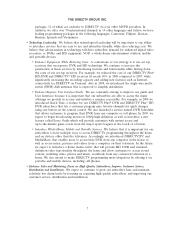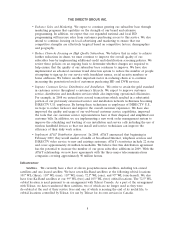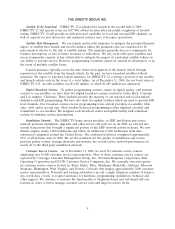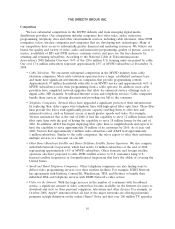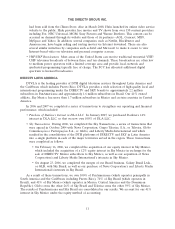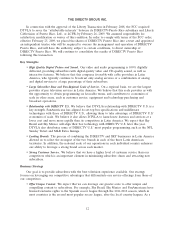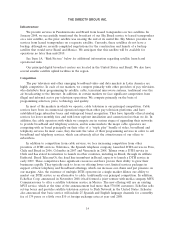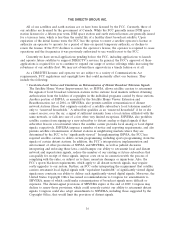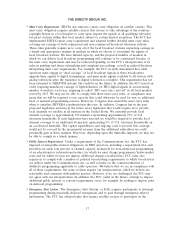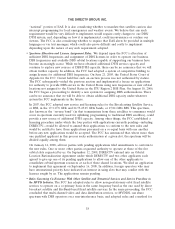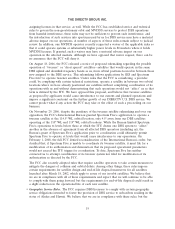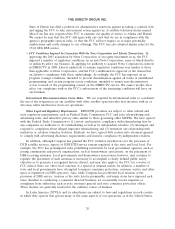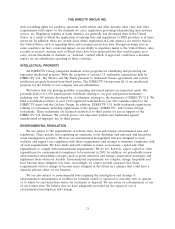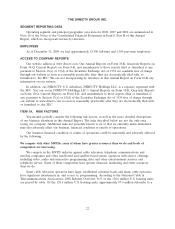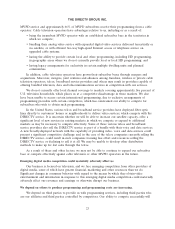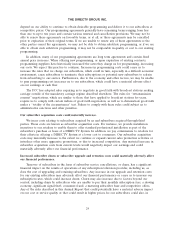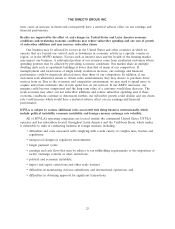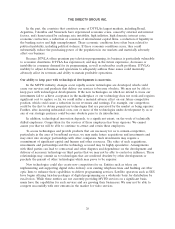DIRECTV 2008 Annual Report Download - page 30
Download and view the complete annual report
Please find page 30 of the 2008 DIRECTV annual report below. You can navigate through the pages in the report by either clicking on the pages listed below, or by using the keyword search tool below to find specific information within the annual report.THE DIRECTV GROUP, INC.
•Must Carry Requirement. SHVIA also imposes a must carry obligation on satellite carriers. This
must carry obligation requires satellite carriers that choose to take advantage of the statutory
copyright license in a local market to carry upon request the signals of all qualifying television
broadcast stations within that local market, subject to certain limited exceptions. The FCC has
implemented SHVIA’s must carry requirement and adopted further detailed must carry rules
covering our carriage of both commercial and non-commercial broadcast television stations.
These rules generally require us to carry all of the local broadcast stations requesting carriage in
a timely and appropriate manner in markets in which we choose to retransmit the signals of
local broadcast stations. We have limited capacity, and the projected number of markets in
which we can deliver local broadcast programming will continue to be constrained because of
the must carry requirement and may be reduced depending on the FCC’s interpretation of its
rules in pending and future rulemaking and complaint proceedings, as well as judicial decisions
interpreting must carry requirements. For example, the FCC recently determined that cable
operators must engage in ‘‘dual carriage’’ of local broadcast signals as these broadcasters
upgrade their signals to digital transmission, and must make signals available to all viewers with
analog televisions after the transition to digital television is complete. This requirement has not
been extended to DBS/DTH systems, but could be in the future. In addition, the FCC issued an
order requiring mandatory carriage of high-definition (or HD) digital signals in an increasing
number of markets each year, requiring so-called ‘‘HD carry-one, carry-all’’ in all local markets
served by 2013. We may not be able to comply with these must carry rules, or compliance may
mean that we will be required to use capacity that could otherwise be used for new or additional
local or national programming services. Moreover, Congress may amend the must carry rules
when it considers SHVERA reauthorization this year. In addition, Congress has in the past
proposed legislation and may in the future enact legislation that would require us to provide
local channels via satellite in all markets in the United States. We currently provide local
channel coverage to approximately 150 markets representing approximately 95% of U.S.
television households. If such legislation were enacted, we would be required to provide local
channel coverage to an additional 60 markets representing 5% of U.S. television households on
an accelerated timetable. The capital expenditures and ongoing costs to provide this coverage
would not be covered by the incremental revenue from the additional subscribers we could
potentially gain in these markets. Moreover, depending upon the timetable imposed, we may not
be able to comply in a timely manner.
•Public Interest Requirement. Under a requirement of the Communications Act, the FCC has
imposed certain public interest obligations on DBS operators, including a requirement that such
providers set aside four percent of channel capacity exclusively for noncommercial programming
of an educational or informational nature, for which we must charge programmers below-market
rates and for which we may not impose additional charges on subscribers. FCC rules also
require us to comply with a number of political broadcasting requirements to which broadcasters
are subject under the Communications Act, as well as limits on the commercialization of
children’s programming applicable to cable operators. We believe that we are in compliance with
all of these requirements, but some of them require our interpretations, which we believe are
reasonable and consistent with industry practice. However, if we are challenged, the FCC may
not agree with our interpretations. In addition, the FCC could, in the future, attempt to impose
additional public interest or content requirements on us, for example, by seeking to impose rules
on indecent programming.
•Emergency Alert System. The Emergency Alert System, or EAS, requires participants to interrupt
programming during nationally-declared emergencies and to pass through emergency-related
information. The FCC has adopted rules that require satellite carriers to participate in the
17


